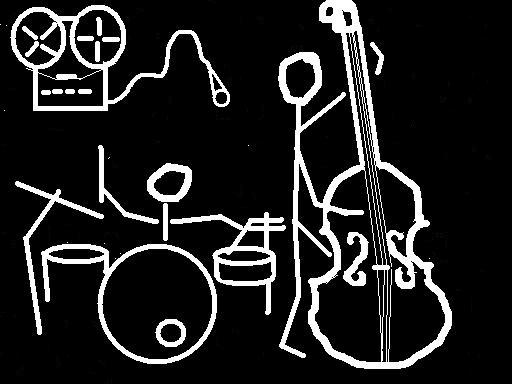 I am thankful for Superland for trusting me with their project, and they even gave me the opportunity to add my own little dub remix at the end of one of their tunes.
I am thankful for Superland for trusting me with their project, and they even gave me the opportunity to add my own little dub remix at the end of one of their tunes. The first two sessions were spent tracking the rhythm section. This was the last time we made a big noise at our old place, 310 West 30th Street in Baltimore, where we had made many, many big noises. Because all of the instruments were electric, except for the drums, I was able to put the whole band in one room together so they could have eye contact and develop their vibe, while I strung their amps all over the house.

The bass amp was in a closet beneath the stairs, the guitar amp was in the bathroom (I always thought bathroom reverb sounded good on guitar), the keyboard amp was in the laundry room, and Nick was laying down some scratch vocals from the dining room one floor above.
As far as the recording system went for the initial tracking session, I originally intended to use my trusty Tascam 38 8-Track reel to reel, but I found that with the amount of takes they wanted to do of each tune, and my lack of 1/2" tape stock,

it would be necessary to go multitrack digital. I am forever in debt to my friend and colleague Zach Herchen for lending me his Digi002 for the session. There was a moment of panic as I had to download a different version of ProTools to run with this hardware, but it worked out. As far as my love of tape, I have the whole session with additional room mics backed up on my cassette 4-track, which was used later in mixing. For drum overheads I used a coincident stereo array of Shure KSM 141. On the Kick, I used a passive 14" PA speaker, rewired, and sent through the mixer with a pad on it. It sounds awesome. BOOM! SM57 on the snare. The amps all had MXL microphones on them. The keyboard (oh yes, "Sally" Rhodes was in full effect) ran through a fender DeVille, as did the electric guitar.
Soon after these sessions, our lease ran out at the 310 house, and thus was the end of an era. However, it was not nearly the end of the project. The percussion, horns, and vocals were all recorded at 2358 Eutaw Place, where I lived for my last month in Baltimore with fellow musicians Alan Munshower, MacGregor Burns, and Dervwife Dave. For these overdubs, I mainly used a Jakelin disk  (based on the Jecklin Disk) for great stereo imaging. Mario's wah saxophone was created by dropping an SM57 inside of his horn, and sending it through an effects pedal and an amplifier. Special shout out to Derv, who lent me his AT4022 for tracking the vocals.
(based on the Jecklin Disk) for great stereo imaging. Mario's wah saxophone was created by dropping an SM57 inside of his horn, and sending it through an effects pedal and an amplifier. Special shout out to Derv, who lent me his AT4022 for tracking the vocals. I left Baltimore with a lot to mix. Many layers of percussion, several takes of horn lines to edit, and plenty of basic tracks from the initial sessions. I moved back to my home town, Brookline MA, and set up shop. To test out the new studio, I first mixed some tracks left over from other Baltimore sessions that I had not yet had the chance to dive into, including an acoustic album for MacGregor Burns, and an EP for Dolphin & The AirMath.
 My greatest obstacle was finding a good natural reverb. I found that my house had too much noise in it to get good room-verb, and my guitar amp spring reverbs were picking up computer and electrical sounds. I settled on an old TOA powered amplifier with a spring reverb unit in it. That, in combination with an occasional digital delay, gave me enough options for playing with depth and space. When I had settled in, the Superland mixing sessions began, and files were sent back and forth through email. The final mixes were bounced through my Allen&Heath Mix Wizard, which gelled everything together, and warmed them up a bit with those nice British electronics. In the future, I would prefer to mix in the same city as the band. Modern technology makes distance more convenient, but there is no substitute for several sets of ears listening in the same room.
My greatest obstacle was finding a good natural reverb. I found that my house had too much noise in it to get good room-verb, and my guitar amp spring reverbs were picking up computer and electrical sounds. I settled on an old TOA powered amplifier with a spring reverb unit in it. That, in combination with an occasional digital delay, gave me enough options for playing with depth and space. When I had settled in, the Superland mixing sessions began, and files were sent back and forth through email. The final mixes were bounced through my Allen&Heath Mix Wizard, which gelled everything together, and warmed them up a bit with those nice British electronics. In the future, I would prefer to mix in the same city as the band. Modern technology makes distance more convenient, but there is no substitute for several sets of ears listening in the same room.



1 comment:
Great article and great job with the album Jake!
Post a Comment